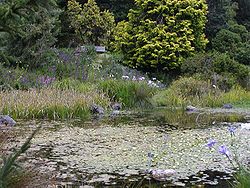San Francisco Botanical Garden
This article needs additional citations for verification. (December 2009) |





The San Francisco Botanical Garden (formerly Strybing Arboretum) is located in San Francisco's Golden Gate Park. Its 55 acres (22.3 ha) include over 50,000 individual plants, representing over 8,000 taxa from around the world, with particular focus on Magnolia species, high elevation palms, and cloud forest species from Central America, South America and Southeast Asia.[citation needed]
San Francisco's County Fair Building is located at the entrance to the garden.
History
Plans for the garden were originally laid out in the 1880s by park supervisor John McLaren, but funding was insufficient to begin construction until Helene Strybing left a major bequest in 1927.[1] Planting was begun in 1937 with WPA funds supplemented by local donations, and the arboretum officially opened in May 1940. As a part of Golden Gate Park, it is officially managed by the city of San Francisco, but the San Francisco Botanical Garden Society plays an important role in providing educational programs, managing volunteers, and curatorial staff. Formed in 1955, the San Francisco Botanical Garden Society (formerly the Strybing Arboretum Society) operates the Helen Crocker Russell Library of Horticulture, a bookstore, and monthly plant sales, and offers a wide range of community education programs for children and adults. The Society also raises money for new projects and Garden renovations. Using green building practices, a new Center for Sustainable Gardening is planned to replace the existing nursery. Other planned renovations include a Southeast Asian Cloud Forest and newly paved pathways.
The Garden continues to actively acquire plants; in 2009 it received 865 accessions totaling over 4,100 individual plants.[citation needed]
Having changed its name from Strybing Arboretum to match that of the San Francisco Botanical Garden Society, the name was changed to San Francisco Botanical Garden Society at Strybing Arboretum and recent signage has dropped the reference to Helene Strybing.
Plant collections
The gardens are organized into several specialized collections:
- Mediterranean
- California Native
- John Muir Nature Trail
- Redwood Grove
- Chile
- Cape Province (South Africa)
- Australia
- Mediterranean Basin Region
- Mild-temperate climate
- New Zealand
- Moon-viewing Garden - a Japanese design
- Takamine Garden - Asian plants
- Temperate Asia Garden
- Montane tropic
- Mesoamerican Cloud Forest
- Southeast Asian Cloud Forest (in development)
- Andean Cloud Forest (in development)
- Specialty collections
The mild Mediterranean climate is ideal for plants from surprisingly many parts of the world; the arboretum does not include greenhouses for species requiring other climate types.
See also
- California native plants
- List of botanical gardens in the United States
- North American Plant Collections Consortium
- 49-Mile Scenic Drive
References
- ^ Sullivan, Michael J. (2004). The Trees of San Francisco, p. 56. Pomegranate Communications, Inc.
External links
- SF Botanical Garden Society homepage
- San Francisco Botanical Garden at Strybing Arboretum and The Commons * http://sfbayview.com/2013/save-the-arboretum-in-golden-gate-park/
- SF Bay Guardian Op Ed on Privatization by San Francisco Botanical Garden Society
- NY Times: Charging Fees to See the Trees
- San Francisco Botanical Garden at Strybing Arboretum and The Commons
